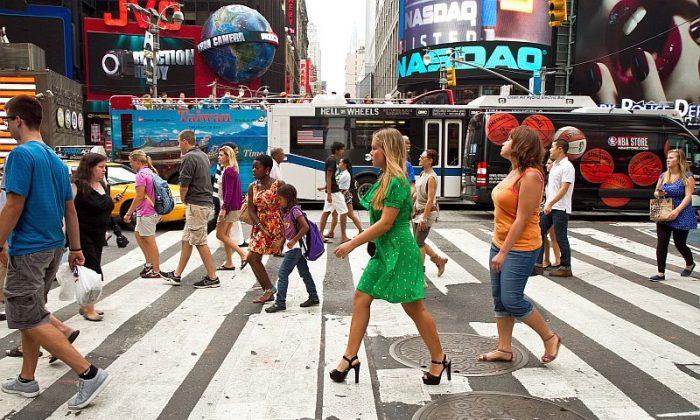NEW YORK—The average American takes only 5,117 steps a day—that’s just shy of 1.5 miles. While New Yorkers’ walking habits are poorly studied, anyone who lives in the city knows the distance of their daily trek is well above the national average.
Walking is certainly great for cardiovascular health, mood, and longevity. But before you laud yourself, think of how many of those numerous steps are taken in poorly constructed shoes, hobbled in torturous high heels, or are simply causing you pain.
“Your feet have to last you a lifetime of travel,” said Dr. Paul Betschart, a podiatrist at Midtown Podiatry. “In New York, you have to walk or you go broke—you can’t take a cab everywhere.”
The Foundation of a Healthy Body
“The more steps you take, the more strains you put on your feet, and the more the little problems people have are going to be magnified,” Betschart said. A search on WebMD’s directory turns up 821 podiatrists in the five boroughs, a testament to that statement.
As with anything, the health of any one part of the body is not isolated. Foot problems affect our posture, attitude, and range of motion, which in turn affect everything else.
“Quite often we have people who are overweight, they have foot problems, and can’t exercise,” Betschart said. “If we can get their foot pain under control, they can get their weight under control. If they get their weight under control, they get less foot pain, too.”
Not everyone has such pressing issues related to foot health, but everyone can benefit from taking some preventative measures. Heel pain is the most common complaint, followed by bunions, corns and calluses, and fungal infections—all of which are preventable.
Getting Properly Shod
“You need a shoe that allows you to walk comfortably without injuring yourself,” Betschart said.
Sounds pretty common sense, right? But many women (and men too) sacrifice function for form. Top shoe no-nos are too tight of a toe box, lack of arch support, inadequate cushioning, and improper balance.
The Louboutin-lovers out there don’t have to give up their collections; but do limit heel wear for short distances or indoor use.
“Back 40, 50 years ago, women used to walk around all the time in high heel shoes. Now we’re starting to wear flats more, and wear sneakers to get to and from work if they have a long walk,” Betschart said. “Heels in small doses are probably not too bad.”
But flats aren’t categorically better. Flip flops and ballet-style slippers that don’t provide protection and support for the foot’s structure can also lead to pain and injury.
A Note on Heel Pain
Heel pain is the most common complaint, but is also low-hanging fruit in the realm of solvable problems. For people whose jobs require them to stand or walk all day, it’s a bit harder to prevent, but for the rest of us, it all comes down to protecting the foot, and learning to prevent further harm while reversing the damage.
Heel pain, also known as plantar fasciitis, is an inflammation of the connective tissue that stretches from the base of the toes, across the arch of the foot, to the point at which it inserts into the heel bone. Walking on the edge of the foot is most common cause of plantar fasciitis. Over time, this causes inflammation.
Podiatrists use a variety of methods to correct this. For starters, anti-inflammatory medications and ice packs reduce the pain; orthotic devices adjust the position of the foot; and most importantly, the patient is taught to walk properly with stretching exercises and physical therapy.
Cautions and Considerations
1. Exercise builds up muscles in the feet and legs and improves circulation, which is especially important if you’re getting older or have diabetes.
2. Make sure to dry between the toes to prevent athlete’s foot and other fungal infection.
3. Posture is affected by the foot. Find out whether you have unequal limb length, scoliosis, and other structural strains that might be contributing to foot pain.
4. Summer’s coming—it’s OK to wear sandals, but make sure they provide proper support. Opt for walking shoes for long periods of walking.
5. Use the proper footwear for your sport.
“If you are a runner, wear a running shoe; don’t run around in your Keds—it’s not enough support, not enough cushioning. If you’re playing basketball or tennis, you have to have a court shoe that provides lateral stability [when you’re moving] side to side. A running shoe that has some heel raise to it can cause ankle instability if you’re doing lateral motions,” said Betschart.
6. The barefoot—martial artists, modern dancers—tend to get impact injuries. “People aren’t used to being barefoot in modern society, so the foot is more tender.” Betschart is not against shoes like Vibram Five Fingers, which promote a barefoot feel, but warns that the body needs to transition to a new way of moving. He recommends his colleague Dr. Emily Splichal, who trains people to run barefoot without injury.







Friends Read Free